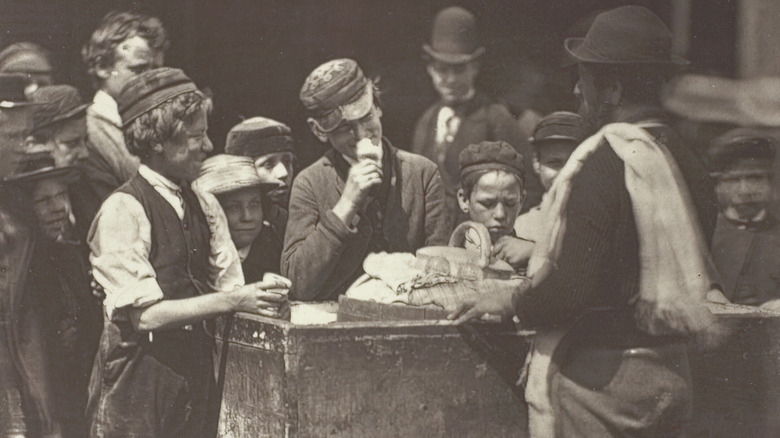Victorian-Era Ice Cream Was So Unsanitary That It Spread Disease
There's a reason why "There's always room for ice cream" is a well-worn expression. Whether you're a jack of all flavors, plain vanilla is your jam, or it must be loaded with chocolate to cross your lips, it can be very hard to resist this beloved treat. That held true in days gone by, as well — which was actually an unfortunate thing for folks in Victorian England, as the early forerunner to today's ice cream was a noted vehicle for spreading disease.
Initially an exclusive offering for the very rich, ice cream became more accessible to the masses in the 19th century thanks to widespread availability of ice houses (structures to store ice during hotter months), and lower sugar prices resulting from the transatlantic slave trade. In England, street vendors began selling ice cream in sizes that cost a penny, half-penny, or two-penny, and the treat became known as a "penny lick."
Penny licks were sold in deceptive glass vessels that looked like they held more ice cream than they really did, and no spoons were included. Buyers would lick out their teeny serving of ice cream and then return the container to the vendor, who would reuse it to serve another "lick" to the next customer. In between servings, the dish was either not washed at all, or, by some accounts, rinsed in a container of sewage-infested water taken from the River Thames.
The outlawing of penny licks and the emergence of the cone
The communal use of penny lick dishes quickly led to the spread of diseases like tuberculosis and cholera in England, and doctors caused a public health outcry regarding ice cream-based infections. Concerns were also raised about the unsanitary conditions in which vendors stored their ice cream ingredients.
The sale of penny licks was ultimately banned in London around 1899, though some rogue vendors continued to employ the outlawed dishes until more widespread bans went into effect in the 1920s and '30s. By the start of the 1900s, though, edible ice cream cups had emerged, eliminating the dangers of communal serving containers. Dishes made of pastry wafers came first, invented by ice cream vendor Italo Marchiony in New York City, followed by the iconic waffle cones, whose invention was a happy accident. These became the new standards for serving the frozen treat.
While today's consumers definitely appreciate a crunchy cone, poor sanitation isn't much of a concern for ice cream lovers these days. A consumer's biggest challenge may be simply how to choose the best ice cream or how long their store-bought treat will stay good in the freezer. Now that's some progress we're happy to celebrate any day!


